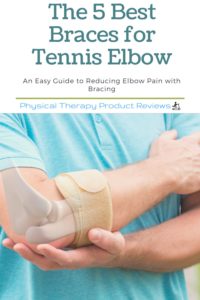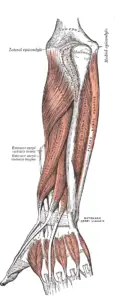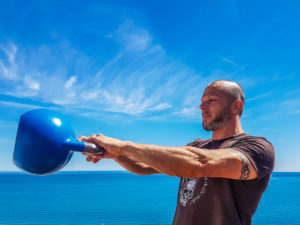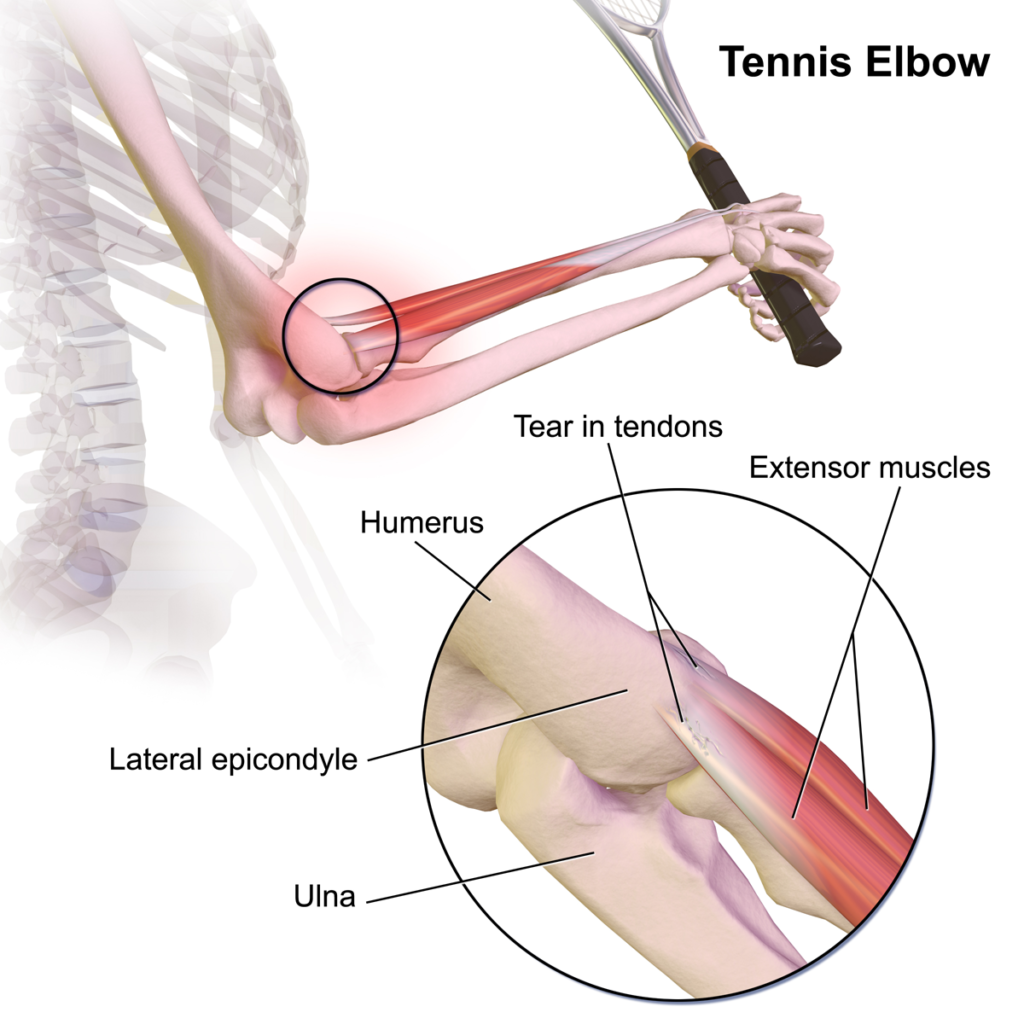One of the most frustrating problems that someone can have is an elbow pain that simply won’t go away. Whether you are experiencing pain at work, while your playing, or doing simple chores at home Tennis Elbow can strike anyone and limit many different aspects of your life.
| Name | Picture | Price | Best Feature | Our rating | Best Price |
|---|---|---|---|---|---|
| Simien Tennis Elbow Brace |
 |
$ | Comes as a 2-pack and with an E-book | 9.6/10 | See Current Price |
| Dashsport Elbow Brace |
 |
$ | Also includes an elbow compression sleeve | 9.6/10 | See Current Price |
| Play Active Elbow Brace |
 |
$ | Inexpensive and Easy to Use | 9.3/10 | See Current Price |
| Witkeen Elbow Brace |
 |
$ | Also includes a GrIp strength ball for resistance | 9.4/10 | See Current Price |
| Bauerfeind Elbow Brace |
 |
$ | Most Supportive for Severe Cases | 9.2/10 | See Current Price |
What is Tennis Elbow or Lateral Epicondylitis
 Tennis Elbow, or Lateral Epicondylalgia, is a painful overuse injury of the lateral elbow. It most commonly affects those that perform repetitive powerful gripping with accompanying arm movement, such as tennis and other racquet sports. However, it can also affect many non-athletes that rely on repetitive hand movement such as worker in the fields of technology, electrical, and hairdressing.
Tennis Elbow, or Lateral Epicondylalgia, is a painful overuse injury of the lateral elbow. It most commonly affects those that perform repetitive powerful gripping with accompanying arm movement, such as tennis and other racquet sports. However, it can also affect many non-athletes that rely on repetitive hand movement such as worker in the fields of technology, electrical, and hairdressing.
Tennis Elbow causes pain on the outside of the elbow where the forearm and wrist extensor muscles originate. By performing repetitive movements, microscopic tears begin to occur within the tendon causing pain and irritation of the nerves and tendon fibers. Tennis elbow is a tendinitis or a tendinopathy of the forearm extensor muscles. Once Tennis Elbow advances, it can become debilitating to use your arm to grip, pull, write, or type. This is extremely difficult! Most jobs require 40 hours a week of those very tasks mentioned.
What is Tendonitis
In the current scientific literature, Tennis Elbow is described as the most common overuse injury in the elbow and forearm, and is 2-3 times more common in athletes who participate in sporting activities more than 2 hours per week (1). Even though it is called “Tennis Elbow” that is a bit of an incorrect nomenclature. Tennis players only account 5% of all the cases (2). Tennis Elbow is equally common among men and women, occurs more frequently in the dominant arm. The incidence does increase with age, peaking between the ages of 30 and 50 (3). Tennis Elbow results in an absence from work of up to 219 workdays, with direct costs $8,099 per person within the United States
Anatomy of Lateral Epicondylitis
 The anatomy of the forearm and wrist is actually quite complex. The elbow joint is comprised of the three bones, the Humerus (upper arm) and the Ulna and Radius (forearm bones). At the distal end of Humerus bone is a protrusion that allows for the forearm muscles and tendons to attach which provides the leverage needed to move the wrist and perform powerful gripping activities in varying positions of the wrist. Take a look at your favorite gymnast on the parallel bars and appreciate the size and tone of their forearm musculature.
The anatomy of the forearm and wrist is actually quite complex. The elbow joint is comprised of the three bones, the Humerus (upper arm) and the Ulna and Radius (forearm bones). At the distal end of Humerus bone is a protrusion that allows for the forearm muscles and tendons to attach which provides the leverage needed to move the wrist and perform powerful gripping activities in varying positions of the wrist. Take a look at your favorite gymnast on the parallel bars and appreciate the size and tone of their forearm musculature.
The human body has to pack numerous muscles, tendons, and nerves into the limited space of the forearm. The two tendons that are most commonly affected with Tennis Elbow are the Extensor Carpi Radialis Brevis (ECRB) and the Extensor Carpi Radialis Longus (ECRL). The ECRB tendon is more common that the ECRL or Extensor Carpi Ulnaris. To isolate the ECRB tendon, palpate the outside of the elbow and straighten the middle finger. You should be able to feel the tendon tighten and pop into your other hand.
Causes of Tennis Elbow
The primary cause of Tennis Elbow is repetitive overuse arm movement, often performed over a longer period of time. Playing sports or working in a profession with repetitive arm movement are important risk factors to consider. Per a recent systematic review the 3 primary risk factors include (5) :
- Handling tools heavier than 1 kg,
- Handling loads heavier than 20 kg at least 10 times per day
- Repetitive movements for more than 2 hours per day
Other risk factors may include training errors in the gym or on the field, misalignments and poor workstation setup, flexibility and tissue length deficits, aging, circulation problems, muscle weakness, muscle imbalances and even psychological factors may play a role.
Symptoms of Tennis Elbow

The most common symptom of Tennis Elbow is pain with palpation on the origin of the extensor muscles on the outside of the elbow, as mentioned above. This pain may worsen with powerful gripping, use of the arm, and holding the wrist in one position for an extended period of time.
Other symptoms include:
- Reports of decreased grip strength
- Pain with gripping and rotating the wrist
- Pain radiating down into the forearm
- Pain with lifting or holding an object
- Pain with typing for long periods of time
Tennis Elbow can be classified into 4 stages based on the severity.
- Mild pain within a couple of hours after using the affected arm
- Pain towards the end of or immediately after using the affected arm
- Pain during the activity which may increase one you finish using the affect arm
- Constant, irritating, debilitating pain with limits activity
Why Wearing a Brace Helps with Tennis Elbow
Bracing for Tennis Elbow is actually quite effective to improve pain, grip strength, and help return to work or recreational sports faster. By applying a brace just distal to the lateral epicondyle this changes the point of tension upon the tendon. Similar to holding down a cord in a string instrument and thus changing the amount of tension when strumming. That means the point of tension has moved from where the tendon attached to the bones to much closer to the wrist.
This means less pull on the irritated tendon, less pain with gripping, and less pain using your dominant hand during every day tasks.
The brace should be placed 2-2.5 cm distal the lateral epicondyle to get the best results.
Once the pain is under control then it is time to strengthen. Eccentric strengthening is really important to help remodel that tendon and will be covered in a separate post. This helps prevent Tennis Elbow from coming back again, because once you’ve had it once, your chances for a second episode remain high.
The Best Braces for Tennis Elbow
SIMIEN Tennis Elbow Brace
Summary: At the top of our list because of everything that you get with this brace including an E-book, 2 padded braces, and a sweat bad for when you get back to slamming that tennis racquet. No clue if the e-book is any good but hopefully the more education the better. The 2 bands allow you to keep one in the gym back and one at work or home. Guaranteed to fit or you can get your money back and comes with a lifetime warranty which if you have read our articles before is a HUGE bonus in our rankings.
Pros
- 2 braces included
- e-book included
- Lifetime warranty
- latex free
Cons
- Comes with a sweatband (didn’t know they still made those)
Dashsport Tennis Elbow Brace
Summary: The Dashsport brace is solid and well made. It does come with a copper compression sleeve and a PDF on instructions and use. We don’t love the copper thing and think the copper infused anything is a gimmick BUT the compression brace may help with pain. We also once again love the 100% money back guarantee so there isn’t much to love here.
Pros
- Comes as a package; a brace and compression sleeve,
- PDF instructions
- 100% Money back guarantee
Cons
- Uses copper as a selling point… which we aren’t sold on through research
Play Active Elbow Brace
Summary: The Play Active elbow brace also comes with a great packaged deal. It comes with 2 braces and 2 extra straps, and great instructions on how to use. This also comes with a digital e-guide to help with the braces and other things to try to reduce your elbow pain. This actually comes with two sizes so for smaller or really large people you might think about ordering these instead of a one size fits all. Finally, as always when searching for products we love the 100% money back guarantee.
Pros
- Comes with 2 straps
- Comes in different sizes
- 100% moneyback guarantee
- Easy to use instructions
Cons
- The instructions and e-guide may be easy to use but some complaints about the guide exist overall
Witkeen Elbow Brace
Summary: The Witkeen pack also includes a bundle but comes with a 40 Lb resistance hand gripper. Comes with 2 braces as well that you can store at home or the office. This also comes with an e-guide that gives strengthening exercises to help with the recovery. Comes with a manufacturer warranty for defective parts and a 60 day money back guarantee no questions and overall customers seem really like this product.
Pros
- Comes with 2 braces
- Added 40 lb grip strengthener
- 60 day Money back guarantee
Cons
- Strap is good for up to 14” forearm musculature
- Not as long of a warranty
Bauerfeind EpiTrain Elbow Support
Summary: The Bauerfeind support is for those that have severe cases of Tennis Elbow. It comes with a compression sleeve with the pad within the compression sleeve. The sleeve is comfortable, well made, and breathable. It comes with more precise sizes to get a better fit for each person. Due to the price we recommend trying a less expensive option first and is only mild relief is achieved go for the Bauerfeind.
Pros
- High quality material
- Great for severe Tennis Elbow
- Great compression sleeve
- Loads of support
Cons
- Pricey as compared to other braces
- May not be a first line brace due to cost
In Review
Tennis Elbow or Lateral Epicondylitis is one of the most frustrating arm injuries if it is allowed to progress and not taken care of early. Stop the pain and progression with an in-expensive elbow brace and get back to your normal activities.
Works Cited
- L.D. Field, F.H. Savoie. Common Elbow Injuries in Sport. Sports Med, 26 (1998), pp. 193-205 https://link.springer.com/article/10.2165%2F00007256-199826030-00005
- Kitai E, Itay S, Ruder A, Engel J, Modan M. An epidemiologocal study of lateral epicondylitis (tennis elbow) in amateur male players. Ann Chir Main Memb Super 5: 113-21, 1986. – https://www.sciencedirect.com/science/article/abs/pii/S0753905386800230?via%3Dihub
- Chard MD, Hazleman BL. Tennis elbow-a reappraisal. Br J Rhematol 28: 187-90, 1989 – https://academic.oup.com/rheumatology/article/28/3/186/1776299
- Silverstein B, Viikari Juntura E, Kalat J. Use of a prevention index to identify industries at high risk for work-related musculoskeletal disorders of the neck, back, and upper extremity in Washington State, 1990-1998. Am J Ind Med. 2002;41:149–169 – https://onlinelibrary.wiley.com/doi/abs/10.1002/ajim.10054
- Van Rijn RM, Huisstede BM, Koes BW, Burdorf A. Associations between work-related factors and specific disorders at the elbow: a systematic literature review. Rheumatology (Oxford). May 2009;48(5):528-36. http://rheumatology.oxfordjournals.org/content/48/5/528.full.pdf
Disclaimer: The information provided in this post is for educational purposes only. This is not a substitute for a medical appointment. Please refer to your physician before starting any exercise program.





